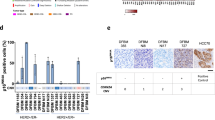Abstract
Brain metastases represent the greatest clinical challenge in treating HER2-positive breast cancer. We report the development of orthotopic patient-derived xenografts (PDXs) of HER2-expressing breast cancer brain metastases (BCBM), and their use for the identification of targeted combination therapies. Combined inhibition of PI3K and mTOR resulted in durable tumor regressions in three of five PDXs, and therapeutic response was correlated with a reduction in the phosphorylation of 4EBP1, an mTORC1 effector. The two nonresponding PDXs showed hypermutated genomes with enrichment of mutations in DNA-repair genes, which suggests an association of genomic instability with therapeutic resistance. These findings suggest that a biomarker-driven clinical trial of PI3K inhibitor in combination with an mTOR inhibitor should be conducted for patients with HER2-positive BCBM.
This is a preview of subscription content, access via your institution
Access options
Subscribe to this journal
Receive 12 print issues and online access
$209.00 per year
only $17.42 per issue
Buy this article
- Purchase on Springer Link
- Instant access to full article PDF
Prices may be subject to local taxes which are calculated during checkout


Similar content being viewed by others
Accession codes
References
Wikman, H. et al. Breast Cancer Res. 14, R49 (2012).
Zhang, L. et al. Nature 527, 100–104 (2015).
Filbin, M.G. et al. Nat. Med. 19, 1518–1523 (2013).
Maire, C.L. et al. Stem Cells 32, 313–326 (2014).
Thorpe, L.M., Yuzugullu, H. & Zhao, J.J. Nat. Rev. Cancer 15, 7–24 (2015).
Elkabets, M. et al. Sci. Transl. Med. 5, 196ra199 (2013).
Krueger, D.A. et al. N. Engl. J. Med. 363, 1801–1811 (2010).
O'Reilly, T. et al. Cancer Chemother. Pharmacol. 65, 625–639 (2010).
Choo, A.Y., Yoon, S.O., Kim, S.G., Roux, P.P. & Blenis, J. Proc. Natl. Acad. Sci. USA 105, 17414–17419 (2008).
Creighton, C.J. Oncogene 26, 4648–4655 (2007).
Brastianos, P.K. et al. Cancer Discov. 5, 1164–1177 (2015).
Shlien, A. et al. Biallelic Mismatch Repair Deficiency Consortium. Nat. Genet. 47, 257–262 (2015).
Hortobagyi, G.N. et al. J. Clin. Oncol. 34, 419–426 (2016).
Gentleman, R.C. et al. Genome Biol. 5, R80 (2004).
Miller, C.A., Hampton, O., Coarfa, C. & Milosavljevic, A. PLoS One 6, e16327 (2011).
Wang, Y. et al. Cell 163, 174–186 (2015).
Love, M.I., Huber, W. & Anders, S. Genome Biol. 15, 550 (2014).
Acknowledgements
We thank D. Livingston for reading the manuscript. We thank R. Modiste and G. Dai at the Dana-Farber Lurie Family Image Center for MRI imaging. We thank R. Bronson and the Dana-Farber/Harvard Cancer Center Rodent Histoplathology Core for histopathological analyses. We thank F. Pan, D. Light and R. Qi (Life Technologies, Thermo Fisher) for assistance with WES and transcriptome analyses with the Ion Torrent sequencing system. We thank J. Ruan and M. Ruan (VigeneTech) for quantification of pS6RP and p4EBP IHC data by the Cellvigene data-analysis program. This work was supported by the Breast Cancer Research Foundation (N.U.L., E.P.W., Z.W. and J.J.Z.); Aid for Cancer Research (E.P.W. and J.J.Z.); Breast Cancer Alliance (J.J.Z.); Komen scholar grant (E.P.W.); and US National Institutes of Health (NIH) grants R01 CA187918 (T.M.R. and J.J.Z.), CA172461 (J.J.Z.), 1K08NS087118 (S.H.R.), P50 CA165962 (T.M.R., K.L.L. and J.J.Z.), P01 CA142536 (J.J.Z.) and 1P50CA168504 (T.M.R., I.E.K., E.P.W., N.U.L., and J.J.Z.).
Author information
Authors and Affiliations
Contributions
J.N., S.H.R., S.X., E.P.W., N.U.L., K.L.L. and J.J.Z. conceived and designed experiments. J.N., S.H.R., S.X., K.L.L. and J.J.Z. developed methodology. J.N., S.H.R., S.X., H.G., V.L., Y.J.K. and M.H. performed the surgeries and the in vitro and in vivo experiments. J.N., S.H.R., S.X., S.G., D.G.S., E.M., K.L.L. and J.J.Z. analyzed and interpreted data. J.N., S.H.R., S.X., S.G., J.D.I., I.E.K., G.-C.Y., T.M.R., E.P.W., N.U.L., K.L.L. and J.J.Z. wrote and/or revised the manuscript. J.N., S.H.R., S.X., L.A.R., Q.-D.N., A.H.L., R.D., E.B.C., B.M.A. and Z.C.W. provided administrative, technical or material support. H.G., V.L., Y.J.K. and M.H. provided technical assistance. E.P.W., N.U.L., K.L.L. and J.J.Z. supervised and coordinated all aspects of the work.
Corresponding authors
Ethics declarations
Competing interests
T.M.R. is a consultant of Novartis and has received a research grant from Novartis. E.P.W. has received research grants from Genentech and Roche. I.E.K. is a consultant of Amgen and has received research funding from Genentech. N.U.L. has received research grants from Genentech, Array Biopharma, GlaxoSmithKline, Kadmon and Novartis.
Supplementary information
Supplementary Text and Figures
Supplementary Figures 1–7 and Supplementary Tables 1–4 (PDF 4482 kb)
Rights and permissions
About this article
Cite this article
Ni, J., Ramkissoon, S., Xie, S. et al. Combination inhibition of PI3K and mTORC1 yields durable remissions in mice bearing orthotopic patient-derived xenografts of HER2-positive breast cancer brain metastases. Nat Med 22, 723–726 (2016). https://doi.org/10.1038/nm.4120
Received:
Accepted:
Published:
Issue Date:
DOI: https://doi.org/10.1038/nm.4120
This article is cited by
-
Cell-cell communication characteristics in breast cancer metastasis
Cell Communication and Signaling (2024)
-
Hsa_circ_0021205 enhances lipolysis via regulating miR-195-5p/HSL axis and drives malignant progression of glioblastoma
Cell Death Discovery (2024)
-
mTOR inhibition abrogates human mammary stem cells and early breast cancer progression markers
Breast Cancer Research (2023)
-
Breast cancer brain metastasis: from etiology to state-of-the-art modeling
Journal of Biological Engineering (2023)
-
p16INK4A-deficiency predicts response to combined HER2 and CDK4/6 inhibition in HER2+ breast cancer brain metastases
Nature Communications (2022)



